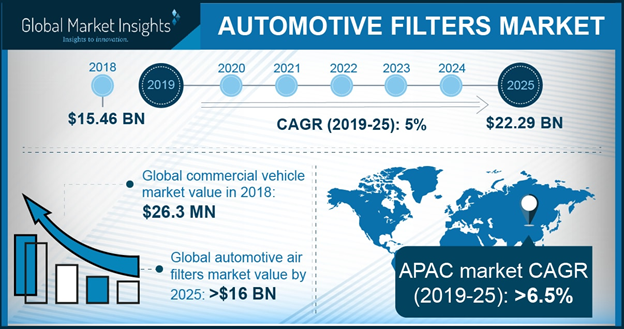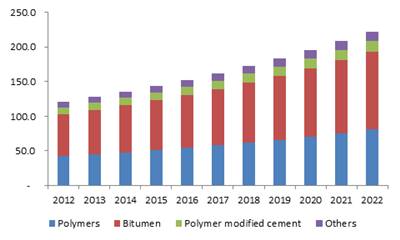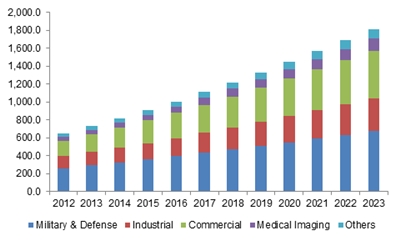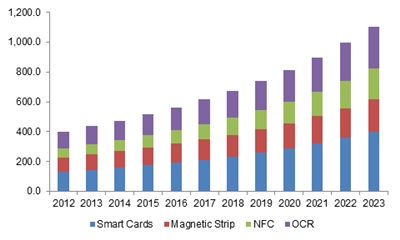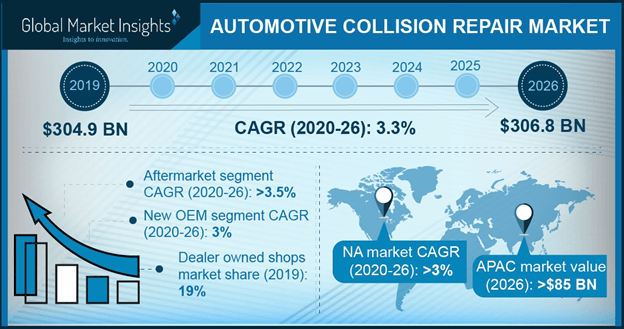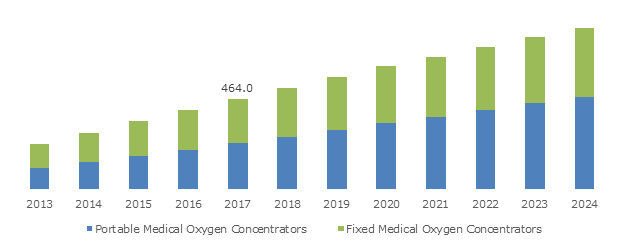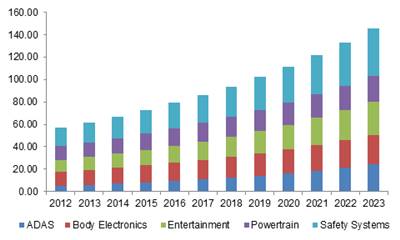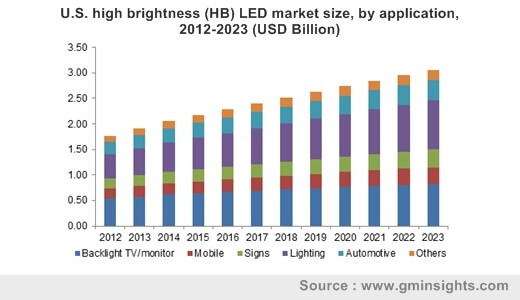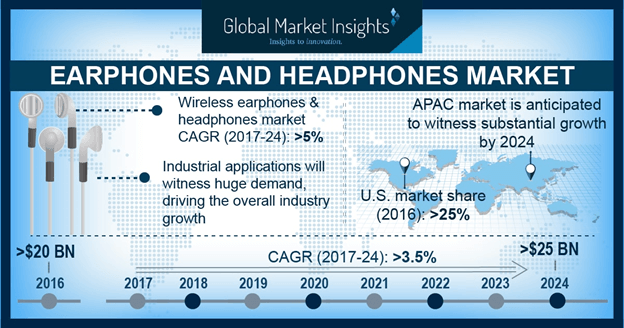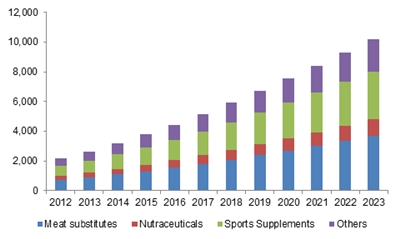Overview
Global Automotive Filters Market size was more than $5.1 billion for 2015
and is predicted to be evaluated at more than $9.51 billion by end of 2023 registering
CAGR of 8.41% during forecast timeline. Automotive filter helps in extending
engine life as it effectively traps debris and dirt that harms internal engine parts
like pistons and cylinders. This device helps appropriate air flow to engine,
thereby maintaining air-fuel mix. Suitable air flow helps engine to operate
perfectly and this minimizes fuel consumption as well as emissions. All these
factors has enhanced the demand for these filters and has encouraged automotive
filters manufacturers to increase their production.
Ecological problems caused due to
emissions of hazardous gases in traditional vehicles has created requirement to
produce ecological friendly substitutes. Electric vehicles sector is predicted
to witness high expansion prospects due to rising consumer demand for less
functional costs & maintenance costs in comparison to fuel powered
automobiles. This is predicted to pose a threat to global automotive filters
market expansion during forecast timeline.
China Automotive Filters Market size, by product, 2012-2023 (USD Million)
Regular substitution is predicted
to result in enhanced fuel mileage by about 14.1%. Further, substituting a blocked
air filter can increase speed by 6.1% to 11.1% on fuel injected automobiles. In
addition to this, this product displays potential ability for gas mileage improvement
and helps in minimizing emissions. Capacity to block waste, dirt and pollution from
entering into fuel lines along with highly stabilized fuel performance and
economy are few of the factors predicted to propel automotive filters market
trends.
Increasing innovation along with growing
consumer demand for added features has boosted industry growth. Favorable rules
and support from agencies like U.S. Environmental Protection Agency (EPA) and
CCC (Civilian Conservation Corps) is predicted to affect industry expansion.
Read full market research report “Automotive Filters Market Size By Product
(Air [Intake, Cabin], Fuel, Oil), By Application (Passenger Cars, Light &
Heavy Commercial Vehicles, Two Wheelers), By End-Use (OEM, Aftermarket),
Industry Analysis Report (U.S., Germany, UK, China, India), Regional Outlook,
Application Potential, Price Trends, Competitive Market Share & Forecast,
2016 – 2023”, please click on the link below:
Product Insights
The industry is segmented into
various products like fuel filters and automotive air filters.
Automotive air filters segment is
predicted to maintain its domination and expected to register 7.81% CAGR during
forecast timeline. Rising health ailments owing to polluted
cabin air coupled with increasing consciousness about high quality air is
anticipated to propel industry demand. Fuel filters segment is predicted to
register CAGR of about 10.51% during forecast timeframe. Rising demand for two
wheelers and passenger cars specifically in BRICS nations is predicted to
promote the segment growth.
Growing health concerns among
world population along with rising rates of pollution is predicted to influence
demand and use of these products. Further, rising consciousness about fuel filtration
& oil filtration significance for long life span of vehicles are few of the
factors driving product demand. In addition to this, new technological
breakthroughs and product innovations have made substantial contribution towards
the growth of these product segments.
Application Insights
Global industry is segmented into
different applications like two wheelers and passenger cars.
Two wheelers segment is predicted
to register more than 8.51% CAGR during forecast timeline. Expansion of the segment can be credited to its rapidly increasing
demand from developing regions like China and India. Significant aftermath of these
automobiles in BRICS nations is predicted to boost segment growth.
Passenger cars segment is
predicted to contribute more than half of the global automotive filters market
share for 2015. Increasing customer disposable income is projected to promote
the demand for these cars. In addition to this, growing health disorders owing
to inappropriate cabin ventilation is expected to favorably affect segment
demand during forecast timeframe.
End Use Insights
The industry is segmented into
various end user applications like automotive filters aftermarket and Original
equipment manufacturer (OEM). Automotive filters aftermarket
segment contributed about $ 3.72 billion for 2015 and is predicted to expand by
more than 70% by end of forecast period. Rising demand for replacement filters
is expected to drive the segment growth and demand.
Original equipment manufacturer
(OEM) segment is anticipated to witness substantial development in future. Concerns
about deployment of aftermarket product is the key factor driving segment
growth. Further, OEM products can provide benefits like annihilation of guarantee
issues and potential quality issues while aftermarket deployment helps in
increasing efficacy and promotes use of perfect media filtration.
Regional Insights
Global automotive filters market
is segmented into key geographical regions like North America, Europe, MEA,
APAC and Latin America. APAC contributed more than 45.1%
of overall revenue and is predicted to register CAGR of more than 9.1% during
forecast timeframe. Expansion of automobile sector in nations like Japan, China
and India is predicted to promote industry demand.
European industry share is
predicted to be more than $2.1 billion by end of 2023. Strict environmental
rules are expected to boost regional industry growth. Further, high level of
public awareness, rise in OEM product demand and rise in automotive filters
market price trends are predicted to stimulate industry growth in the region. U.S. industry is featured by
evolving electric automobile demand as these vehicles do not require product
substitutes.
Competitive Insights
Key industry players profiled in
the report include Cummins Incorporation, Ahlstrom Corporation, Denso
Corporation, Freudenberg & Co. Kg, Hollingsworth & Vose Company Incorporation,
Lydall Incorporation, Mann Hummel, Neenah Paper Incorporation, ALCO filters, Robert Bosch GmbH, Metsurama
Filtration, Parker Hannifin Corporation, Sogefi S.p.A., Valeo SA, Purofil Auto
(India) Private Limited, Viking
Filters, Toyota Boshoku Corporation, Dongguan
Lvmeng Industrial Company Limited, Clarcor Incorporation, Roki Company Limited, ACDelco Incorporation, Fram/UCI, Donaldson
Company Incorporation, Hengst SE & Co. KG, K&N Engineering Incorporation
and Mahle GmbH.
Information Source: Global Market Insights, Inc
